Millingtonia hortensis
Oroxylum indicum
compiled by U Kyaw Tun, U Pe Than, and staff of TIL. Not for sale.
Family: Bignoniaceae 2 entries
Millingtonia hortensis
{E-ka.raaz ping}
Oroxylum indicum
{kraung-lhya}
Main Index of DB |
Top
Contents of this page
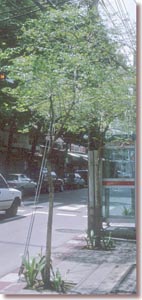
Ref. Burmese-Myanmar transcript names:
Agri.Dept.2000 : NL
FAO : NL
Lθ-seik-shin 495:
{E-ka.raaz ping}
KS-TMN 69:Aegayit
Nagathein 4-105:
{E-ka.raaz ping}
UHM : NL
Myanmar-Script Spelling
Official Myanmar Dictionaries
{E-ka.raaz}-
--
TravPo-M-Dict 384
{E-ka.raaz} - n. 1 monarch, emperor, king. 2 tree of medicinal value,
Millingtonia hortensis -- Myan-Engl-Dict 613
UKT:Both {lθy-seik-shing:} and Nagathein gave the name as
{E-ka.raaz ping}, where
{ping} or "tree" appeared as the suffix. Without the prefix, the word can be mistaken for "monarch".
Hindi
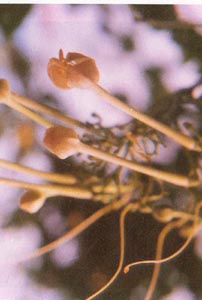
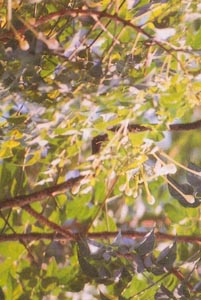
{a-ka-thhya.nim} -- Nagathein
Sanskrit
English common name used in Myanmar :
Agri.Dept.2000 : NL
FAO : NL
Lθ-seik-shin 495: Tree jasmine, Indian cork tree
KS-TMN 69: Indian Cork Tree
Nagathein 4-105: Tree jasmine
UHM : NL
Leader from
http://www.bma.go.th/garden/tree/mihor/mihor1.jpg
Photos: left -- habit with flowers, right --
flowers close up -- KS-TMN
An erect tree; branches drooping, bark corky. Leaves opposite, tripinnately compound; exstipulate; petiolate; petiolulate, the upper tertiary leaflets sessile; exstipellate; leaflets ovate-lanceolate, the bases rounded or cuneate, the margins serrate, the tips acuminate, pubescent when young, glabrescent. Inflorescences in paniculate cymes, terminal or axillary, the cymules 3-flowered; bracts minute. Flowers ebracteolate, pedicellate, besexual, zygomorphic, pentamerous, hypogynous. Calyx synsepalous, 5-toothed, campanulate. Corolla synpetalous, 5-lobed,infundibuliform, the tube long, slender, cylindrical, white. Androecium didynamous, stamens 4,epipetalous, the filaments shortly exserted, the anthers dithecous, one cell ovoid, the second cell appearing as a small hook, white, dehiscence longitudinal; disc small, cushion-like. Pistil 1, ovary subsessile, 2-carpelled, syncarpous, 2-loculed, the placentation axile, the ovules numerous in each locule, the style long, the stigma 2-lobed, ellipsoid. Fruit a 2-valved septicidal capsule, oblongoid, acute at both ends, flat, woody; seeds discoid, compressed, winged, except the base, the wing narrow at the apex, non-endospermic. Flowering period: October - December. Fruiting period: November - February -- KS-TMN
The
{E-ka.raaz ping} grows to a height of some 80 feet and 3 to 4 feet in girth. It
is usually grown along roadsides and in gardens. Relatively few branches with a
straight trunk. The leaves are similar to those of
{pan:ta.ma}. (Melia burmanica -- Nagathein 2-005). Though flowers are like {mrat-lι:pan: a.hpru},
they are longer and larger. White flowers with a faint sweet smell. Flowering
period: months of {thi-ting:kywut} to {nat.tau} (October - December) --
Nagathein, free translation by UKT.
Commonly grows wild or planted throughout Myanmar. -- KS-TMN
Leaf and root -- Hypertension; Plague; Stimulating effect on cardiovascular system; Purify blood; Alcohol intoxication; Antidote for poisons. Root -- Leucoderma; Muscle stiffness; Alcohol intoxication; Giddiness. Leaf -- Small pox; Amenorrhoea -- KS-TMN
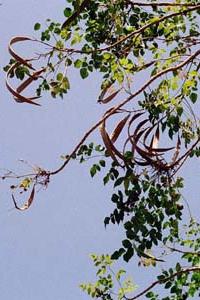
Ref. Burmese-Myanmar transcript names:
Agri.Dept.2000 09-0222:
{kraung-lhya}
FAO : NL
Lθ-seik-shin 083:
{kraung-lhya}
KS-TMN 070: Kyaung-sha
Nagathein 1-194 :
{kraung-lhya}
UHM : NL
Myanmar-Script Spelling
Official Myanmar Dictionaries 033:
{kraung-lhya} -
--
TravPo-M-Dict 033
{kraung-lhya} - n. the Indian trumpet, Bignonia indica -- Myan-Engl-Dict
043
Hindi
{hso-na-pa-Hta}
Sanskrit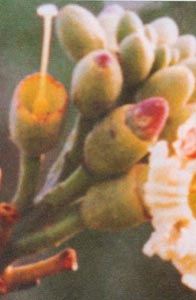
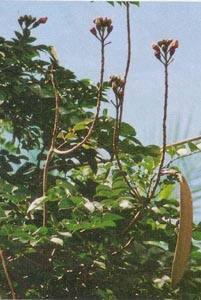
English common name used in Myanmar :
Agri.Dept.2000 09-0222: Trumpet flower
FAO : NL
Lθ-seik-shin 083: Indian Trumpet flower
KS-TMN 070: Indian Trumpet flower
Nagathein 1-194 : not given
UHM : NL
Leader from
http://home.hiroshima-u.ac.jp/shoyaku/photo/Thai/Oroxylum.jpg
Photos: left -- habit with flowers and fruits,
right -- flowers close up -- KS-TMN
http://home.hiroshima-u.ac.jp/shoyaku/photo/Thai/Oroxylum.jpg
A small tree, deciduous; bark light brown, corky, lenticels numerous, the younger stems glabrous. Leaves opposite, decussate, decompound, ternate; exstipulate; petiolate; petiolules short; exstipellate; leaflets ovate or elliptic, the bases rounded or obtusely acute, the margins entire, the tips acute to acuminate, the surfaces glabrous. Inflorescences terminal racemes; peduncles long, stout; bracts distinct. Flowers ebracteolate, pedicellate, bisexual, zygomorphic, pentamerous, hypogynous. Calyx synsepalous, 5-lobed, campanulate, coriaceous, persistent. Corolla synpetalous, 5-lobed, campanulate, ventricose, the lobes orbicular, subequal, crisped, reddish purple, fleshy, caducous. Androecium polyandrous, stamens 5, epipetalous, inserted, the filaments straight, 4 subequal, the fifth one shorter, the bases woolly, the anthers dithecous, oblongoid, divergent below, the connective with a short mucro, basifixed, introrse, dehiscence longitudinal; disc large, fleshy,. Pistil 1, ovary oblongoid, subsessile, 2-carpelled, syncarpous, 2-loculed, the placentation axile, the ovules numerous in each locule, the style filiform, the stigma 2-lobed. Fruit a 2-valved septifragal capsule, oblongoid, tapering to both ends, flat, valves semiwoody; seeds discoid, compressed, numerous, with a broad hyaline wing, non-endospermic. Flowering period: June - July. Fruiting period: July - September -- KS-TMN
There are three kinds of
{kraung-lhya}: {kraung-lhya kri:}, {kraung-lhya lak-to}, and {kraung-lhya hsu:pauk},
differing in size of the fruits. The well-known common {kraung-lhya} is
{kraung-lhya kri:} and the fruits hang down. The fruit of
{kraung-lhya lak-to} is smaller and stands upright.
{kraung-lhya ping} belongs to the "basic medicinal group of ten". Myanmars use
{kraung-lhya} fruit not only as medicine, but also as food in various ways. The
leaves, softened by boiling, are eaten as vege-mate of hot fish paste. --
Nagathein, free translation by UKT.
UKT: One of the favorite ways of eating boiled or steamed rice is to put together a bit of chilies-hot fish paste, a bite of fresh or softened vegetable (leaf or fruit) and a small lump of rice. The whole is eaten as one morsel. The vegetable that goes with the fish-paste is termed "vege-mate". Young and tender shoots and leaves (sour, bitter, green-taste -- but not sweet) of almost all plants can be eaten as vege-mate.
Oroxylum indicum a.k.a. Broken Bones Plant, Indian Trumpet Flower, Tree of Damocles. Odd, upright growing tree known for several fear-provoking ornamental attributes, as well as its use in cooking and medicinal treatments. The tree is often grown as an ornamental for its strange appearance. The long, podded fruits hang down from bear branches, looking like dangling sickles or swords in the night. The tree is also a night-bloomer and is pollinized naturally by bats. Additionally, after the large leaf stalks wither, they fall off the tree and collect near the base of the trunk, appearing to look like a pile of broken limb bones. Evergreen or partly deciduous tree to 50-60ft. Flowers bloom at night and emit a strong, stinky odor which attracts bats. Tropical tree, but it may survive to as low as 32F for brief periods. We had seedlings that survived low 40's temperatures with little problem. Propagation: By seed. Native to India and Southern China. -- http://www.tradewindsfruit.com/midnight_horror.htm
Commonly grows wild throughout Myanmar. Also cultivated. -- KS-TMN
Root bark, fruit -- Good for the treatment of heart and neck diseases; Haemorrhoids; Abdominal tumours; Infections; Flatulence; as an expectorant. Plant -- Leprosy; Diarrhoea; Dyspepsia; Cough; Infections; Nausea, Vomitting; Abscess; Flatulence. Root bark -- Neurological disorders; Life saver; Asthma; Cough; Migraine; Indigestion; Postpartum uterus contraction pain; Gynaecological diseases. Leaf -- Oropharyngeal ulcer; Opium intoxication. Flower -- Improves appetite. -- KS-TMN
Entry format: Botanical name / Family / Ref. Burmese-Myanmar
transcripts ( Agri.Dept.2000 :
Chklist: LSR : FAO : KS-TMN:
Nagathein :
UHM :/ Myanmar-Script Spelling (
Official Myanmar Dictionaries : - TravPo-M-Dict - Myan-Engl-Dict - Myan-Ortho
/ Hindi /
Sanskrit / English common name used in Myanmar / Picture /
Plant identification characters / Distribution in Myanmar / Part
used and uses / Constituents /
End of TIL file